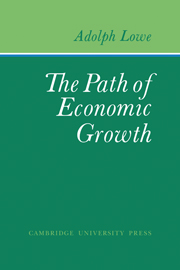Book contents
- Frontmatter
- Contents
- Preface
- Acknowledgments
- PART I The Basic Model
- 1 Introduction: Scope and Method
- 2 Patterns of Economic Growth
- 3 A Schema of Industrial Production
- 4 The Circulation of Fixed Capital
- 5 The Circulation of Working Capital
- 6 The Stationary Process in Operation: Structure Analysis
- 7 The Stationary Process in Operation: Force Analysis
- 8 Transition to Dynamic Equilibrium
- 9 Dynamic Equilibrium: Structure Analysis
- 10 Dynamic Equilibrium: Force Analysis
- PART II Changes in the Rate of Change
- PART III Changes in the Rate of Change
- PART IV Changes in the Rate of Change
- Appendix: An Alternative Presentation of Lowe's Basic Model
- Glossary of Recurring Symbols
- Name Index
- Subject Index
5 - The Circulation of Working Capital
Published online by Cambridge University Press: 07 October 2011
- Frontmatter
- Contents
- Preface
- Acknowledgments
- PART I The Basic Model
- 1 Introduction: Scope and Method
- 2 Patterns of Economic Growth
- 3 A Schema of Industrial Production
- 4 The Circulation of Fixed Capital
- 5 The Circulation of Working Capital
- 6 The Stationary Process in Operation: Structure Analysis
- 7 The Stationary Process in Operation: Force Analysis
- 8 Transition to Dynamic Equilibrium
- 9 Dynamic Equilibrium: Structure Analysis
- 10 Dynamic Equilibrium: Force Analysis
- PART II Changes in the Rate of Change
- PART III Changes in the Rate of Change
- PART IV Changes in the Rate of Change
- Appendix: An Alternative Presentation of Lowe's Basic Model
- Glossary of Recurring Symbols
- Name Index
- Subject Index
Summary
Working capital is one of the neglected issues in neoclassical literature. As a matter of fact, very little of analytical use has been handed down to us even from classical writings. After two false starts by Smith and Ricardo, both trying to find a distinction between “fixed” and “circulating” capital, the latter concept became more and more identified with the “wage fund” and, thus, with one of the most dubious constructs of classical economics. Neither Jevons nor the founders of either the Lausanne School or the earlier Cambridge School had anything substantial to contribute to further clarification. The situation improved only much later, especially through F. W. Taussig's study on Wages and Capital, and with Boehm-Bawerk's version of the structure of production, which is really a special model of the circulation of working capital. Once again, J. B. Clark deserves mention. Without going into details, Clark makes the decisive distinction between active capital goods that perform an act of “transformation” and “perish in the using” and passive capital goods that are being transformed but “mature” rather than being destroyed during the process of production.
The next one to add to clarification was D. H. Robertson, whose famous analogy of the process of production with a sausage machine has helped to give to the notion of an “average period of production” as much meaning as can be bestowed upon it. Of more recent contributions I should like to mention those by Keynes, Neisser, Lundberg, Hicks, and Wyler.
- Type
- Chapter
- Information
- The Path of Economic Growth , pp. 48 - 54Publisher: Cambridge University PressPrint publication year: 1976



